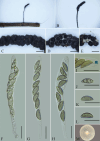Morphology and multigene phylogeny reveal four new Xylaria (Xylariales, Xylariaceae) species from karst region in China
- PMID: 39268505
- PMCID: PMC11391122
- DOI: 10.3897/mycokeys.108.130565
Morphology and multigene phylogeny reveal four new Xylaria (Xylariales, Xylariaceae) species from karst region in China
Abstract
This study presents the identification of four novel Xylaria species, discovered in the karst region of China. The discovery was facilitated by a rigorous analysis that encompassed both morpho-anatomical features and multi-locus phylogenetics utilizing sequences from the ITS, rpb2, and TUB2 loci. The newly identified species are designated as Xylariajichuanii sp. nov., X.nanningensis sp. nov., X.orientalis sp. nov., and X.taiyangheensis sp. nov. The distinction of these species from their known counterparts was verified through comparison of morphological features and phylogenetic analysis. The study further provides detailed morphological descriptions, illustrative representations, and a phylogenetic tree, all of which contribute to the taxonomic positioning of these novel species.
Keywords: Folicolous fungi; Fungal systematics; Southwest China; Xylariaceae; taxonomy.
Wenyu Zeng, Kamran Habib, Xin Zhou, Yulin Ren, Xiangchun Shen, Bei Wang, Yingqian Kang, Jichuan Kang, Qirui Li.
Conflict of interest statement
The authors have declared that no competing interests exist.
Figures





References
-
- Daranagama DA, Camporesi E, Tian Q, Liu X, Chamyuang S, Stadler M, Hyde KD. (2015) Anthostomella is polyphyletic comprising several genera in Xylariaceae. Fungal Diversity 73: 203–238. 10.1007/s13225-015-0329-6 - DOI
-
- Dayarathne MC, Jones EB, Maharachchikumbura SS, Devadatha B, Sarma VV, Khongphinitbunjong K, Chomnunti P, Hyde KD. (2020) Morpho‐molecular characterization of microfungi associated with marine based habitats. Mycosphere 11(1): 1–188. 10.5943/mycosphere/11/1/1 - DOI
-
- Dennis RWG. (1956) Some Xylaria of tropical America. Kew Bulletin 11: 401–444. 10.2307/4109126 - DOI
LinkOut - more resources
Full Text Sources
